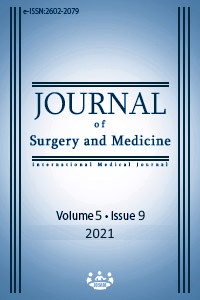Combination of the Simplified Modified Geneva and Wells Clinical Prediction Scoring promise a good performance in pulmonary embolism diagnosis
Keywords:
Keywords: Pulmonary thromboembolism, computed tomograhy pulmonary angiography, Wells Clinical Scoring, Simplified Modified Geneva ScoreAbstract
Background/Aim: Pulmonary thromboembolism (PTE) has high mortality and morbidity, is difficult to diagnose, and is generally preventable. Clinical scoring is used for early diagnosis. Two of these often-used scoring systems include the Wells and Simplified Modified Geneva scoring systems. We aimed to comparatively determine the values of the Wells and the Simplified Modified Geneva scoring systems in showing PTE. Methods: This prospective cohort study included 195 patients who underwent computerized tomography pulmonary angiography (CTPA) with suspected PTE between May 2018 and November 2018. The Wells and Simplified Modified Geneva scores of the patients were calculated. Wells Clinical Scoring results were grouped as having a weak/strong probability of PTE, while those of the Modified Geneva clinical scoring were categorized as possible/unlikely PTE. The analyses were performed with the SPSS package 21.0 program. Results: One hundred and nine (55.9%) patients presented to the emergency department and eighty-six (44.1%) patients visited the outpatient clinic for chest diseases. Of all cases, 83 (42.6%) were male and 112 (57.4%) were female. The mean age was 57.16 (18.62) years. Forty-one (21%) patients had PTE. The sensitivity and specificity of Wells Clinical Scoring for PTE were 87.8% and 83.8%, respectively, while those of the Simplified Modified Geneva Clinical Scoring were 82.9% and 53.3%, respectively. The chi-square analysis for two clinical scorings revealed a p-value of 0.001. The negative predictive values of Wells and Simplified Modified Geneva Scores were 96.2% and 92.1%, respectively. The positive predictive value was the highest in the emergency department (80% and 39.4%, respectively). When the two clinical scores were used together, the negative and positive predictive values were 95.6% and 61.1%, respectively. Conclusion: We found that Wells Clinical Scoring is superior to the Simplified Modified Geneva Score in terms of sensitivity and specificity. The use of these two clinical scores in the outpatient clinic was more useful in excluding PT, while in the emergency department, their combination was more effective in diagnosing it.
Downloads
References
Sandler DA, Martin JF. Autopsy proven pulmonary embolism in hospital patients: are we detecting enough deep vein thrombosis. J R Soc Med. 1989 Apr;82(4):203-5. doi: 10.1177/014107688908200407.
Heit JA. The epidemiology of venous thromboembolism in the community. Arterioscler Thromb Vasc Biol. 2008 Mar;28(3):370-2. doi: 10.1161/ATVBAHA.108.162545 .
Cohen AT, Dobromirski M, Gurwith MM. Managing pulmonary embolism from presentation to extended treatment. Thromb Res. 2014 Feb;133(2):139-48. doi: 10.1016/j.thromres.2013.09.040.
Nijkeuter M, Söhne M, Tick LW, Kamphuisen PW, Kramer MH, Laterveer L, et al. The natural course of hemodynamically stable pulmonary embolism: Clinical outcome and risk factors in a large prospective cohort study. Chest. 2007 Feb;131(2):517-23. doi: 10.1378/chest.05-2799.
Konstantinides SV, Torbicki A, Agnelli G, Danchin N, Fitzmaurice D, Galiè N, et al. 2014 ESC guidelines on the diagnosis and management of acute pulmonary embolism. Eur Heart J. 2014 Nov 14;35(43):3033-69, 3069a-3069k. doi: 10.1093/eurheartj/ehu283.
Wicki J, Perneger TV, Junod AF, Bounameaux H, Perrier A. Assessing clinical probability of pulmonary embolism in the emergency ward: a simple score. Arch Intern Med. 2001 Jan 8;161(1):92-7. doi: 10.1001/archinte.161.1.92 .
Ceriani E, Combescure C, Le Gal G, Nendaz M, Perneger T, Bounameaux H, et al. Clinical prediction rules for pulmonary embolism: a systematic review and meta-analysis. J Thromb Haemost. 2010 May;8(5):957-70. doi: 10.1111/j.1538-7836.2010.03801.x .
Le Gal G, Righini M, Roy PM, Sanchez O, Aujesky D, Bounameaux H, et al. Prediction of pulmonary embolism in the emergency department: the revised Geneva score. Ann Intern Med. 2006 Feb 7;144(3):165-71. doi: 10.7326/0003-4819-144-3-200602070-00004.
Douma RA, Mos IC, Erkens PM, Nizet TA, Durian MF, Hovens MM, et al. Performance of 4 clinical decision rules in the diagnostic management of acute pulmonary embolism: a prospective cohort study. Ann Intern Med. 2011 Jun 7;154(11):709-18. doi: 10.7326/0003-4819-154-11-201106070-00002.
Penaloza A, Melot C, Motte S. Comparison of the Wells score with the simplified revised Geneva score for assessing pretest probability of pulmonary embolism. Thromb Res. 2011 Feb;127(2):81-4. doi: 10.1016/j.thromres.2010.10.026.
Klok FA, Mos IC, Nijkeuter M, Righini M, Perrier A, Le Gal G, et al. Simplification of the revised Geneva score for assessing clinical probability of pulmonary embolism. Arch Intern Med. 2008 Oct 27;168(19):2131-6. doi: 10.1001/archinte.168.19.2131.
Hall WB, Truitt SG, Scheunemann LP, Shah SA, Rivera MP, Parker LA, et al. The prevalence of clinically relevant incidental findings on chest computed tomographic angiograms ordered to diagnose pulmonary embolism. Arch Intern Med. 2009 Nov 23;169(21):1961-5. doi: 10.1001/archinternmed.2009.360.
Wells PS, Anderson DR, Rodger M, Ginsberg JS, Kearon C, Gent M, et al. Derivation of a simple clinical model to categorize patients probability of pulmonary embolism: increasing the models utility with the SimpliRED D-dimer. Thromb Haemost. 2000 Mar;83(3):416-20.
van Belle A, Büller HR, Huisman MV, Huisman PM, Kaasjager K, Kamphuisen PW, et al. Effectiveness of managing suspected pulmonary embolism using an algorithm combining clinical probability, D-dimer testing, and computed tomography. JAMA. 2006 Jan 11;295(2):172-9. doi: 10.1001/jama.295.2.172.
Posadas-Martínez ML, Vázquez FJ, Giunta DH, Waisman GD, de Quirós FG, Gándara E. Performance of the Wells score in patients with suspected pulmonary embolism during hospitalization: a delayed-type cross sectional study in a community hospital. Thromb Res. 2014 Feb;133(2):177-81. doi: 10.1016/j.thromres.2013.11.018.
Righini M, LE Gal G, Perrier A, Bounameaux H. Clinical probability assessment of pulmonary embolism by the Wells' score: is the easiest the best. J Thromb Haemost. 2006 Mar;4(3):702-4. doi: 10.1111/j.1538-7836.2006.01797.x.
van Es N, Kraaijpoel N, Klok FA, Huisman MV, Den Exter PL, Mos IC, et al. The original and simplified Wells rules and age-adjusted D-dimer testing to rule out pulmonary embolism: an individual patient data meta-analysis. J Thromb Haemost. 2017 04;15(4):678-84. doi: 10.1111/jth.13630.
Downloads
- 923 544
Published
Issue
Section
How to Cite
License
Copyright (c) 2021 Gökhan Çoraplı, Ayşe Füsun Topçu
This work is licensed under a Creative Commons Attribution-NonCommercial-NoDerivatives 4.0 International License.
















